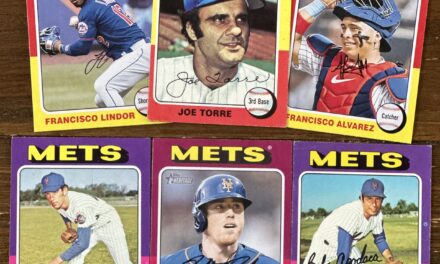![]()
It’s been a decade since we lost “Kid.” The memories of Gary Carter still center on life — and how much he had while present.
If Keith Hernandez was the brains of the 1986 Mets, Carter was its heart. That might sound corny, but it’s fitting for the legendary catcher we knew and loved. Opposing fans, players, and even his teammates found his wholesome, virtuous persona mawkish, downright nauseating, and phony. Maybe Carter overindulged the media — certainly not the worst characteristic to lay upon a ballplayer. But the media had reason to give him attention.
He was one of four catchers to reach 300 homers, 2,000 hits, 1,000 runs batted in, and 1,000 runs scored. He remains second among all backstops with a 26.1 defensive WAR and fourth with a 56.3 offensive WAR. Not only was Carter one of the best behind the plate, but he was also one of the most durable. By the time he retired in 1992, he played in a National League record 2,056 games behind the plate and held major league marks for career putouts (11,785) and total chances (12,988) at the position.
Yet it took Carter an agonizing six years to make the Hall of Fame. When it was finally his time in 2003, he became the first — and to this date, only — member of the last Mets championship team to be inducted.
For his first 12 seasons, Carter was the toast of Montreal. Merging defensive instincts and a power bat, he led the league in nabbing potential base stealers three times and posted six seasons of hitting 20 or more home runs while raising the stature of the Expos franchise.
Mirroring what Rusty Staub did before him, Carter embraced the French-Canadian culture. Coupled with hustle and exuberance, which helped earned him the “Kid” moniker, his enhanced visibility rankled those around him. Carter didn’t know any other way.
The All-Star Game served as an ideal showcase for the catcher with the irrepressible smile. He won MVP twice, including in 1984, when he spent two innings catching a young phenom pitcher named Dwight Gooden. It was a sneak preview of what was to come.
His durability started to fade in New York, but by then he got what he came for: a championship ring. A stunning trade from Montreal to New York in December ’84 turned the Mets from hopeful contenders into bonafide contenders. Carter offered a storybook debut — a walk-off homer at chilly, windy Shea Stadium on Opening Day to beat the Cardinals. He overcame damaged knees to hit 32 homers and drive in 100 runs as New York fell just short of St. Louis in the NL East race.
Carter’s last great season was in ’86, but it ended in storybook fashion. He set a franchise record with 105 RBIs. More importantly, the Mets had 108 wins to cruise into the playoffs. he delivered crucial hits in October — none more than the single to keep Game 6 of the World Series alive.
After 13 years, Carter had the ring that had eluded him. It was the high point in a career that began its descent the next season, as those wretched knees further impeded his ability. Being “Kid” was true in nickname and demeanor only. He hit .231 from 1987 through ’89 and saw his power numbers regress steadily. He did manage to reach 300 career home runs and earn co-captainship alongside Keith Hernandez. Carter was named to the last of his 11 All-Star Games, but he was no longer a premier catcher.
By 1989, injuries restricted Gary to just 153 at-bats. His streak of 12 straight seasons of playing in at least 100 games came to an end. So too did his contract. With days in New York numbered, he still provided one last memory. In his final appearance at Shea Stadium as a Met, he proved as much a man for the moment as he was when he debuted, Carter doubled down the left-field line — which led to a standing ovation as he exited the field.
He moved on from the Mets after ’89 and finished his career with the Giants, Dodgers, and then a last hurrah with the Expos in 1992.
Carter’s overall numbers in New York aren’t on par with the Hall-worthy numbers he posted in Montreal. But he had an indisputable impact on vaulting the Mets to the top and doing so with childlike joy and unshakable determination.
His call to Cooperstown evoked memories from Expos fans and Mets fans alike. Those memories became more poignant when he succumbed to brain cancer eight months after diagnosis. In the time since his passing, Carter’s legacy is not only of an outstanding player but an exemplary person who had a love of the game like few others.















